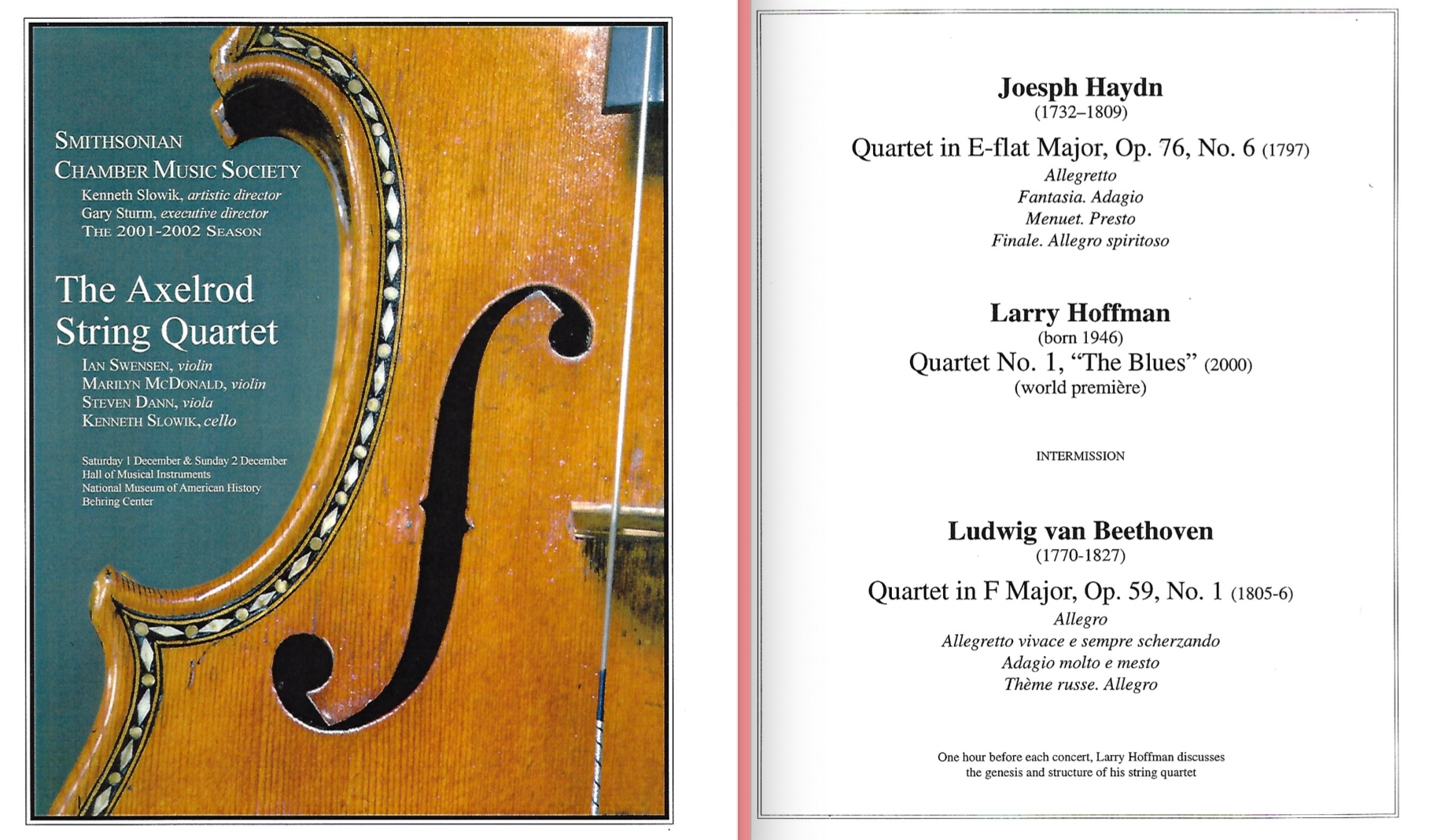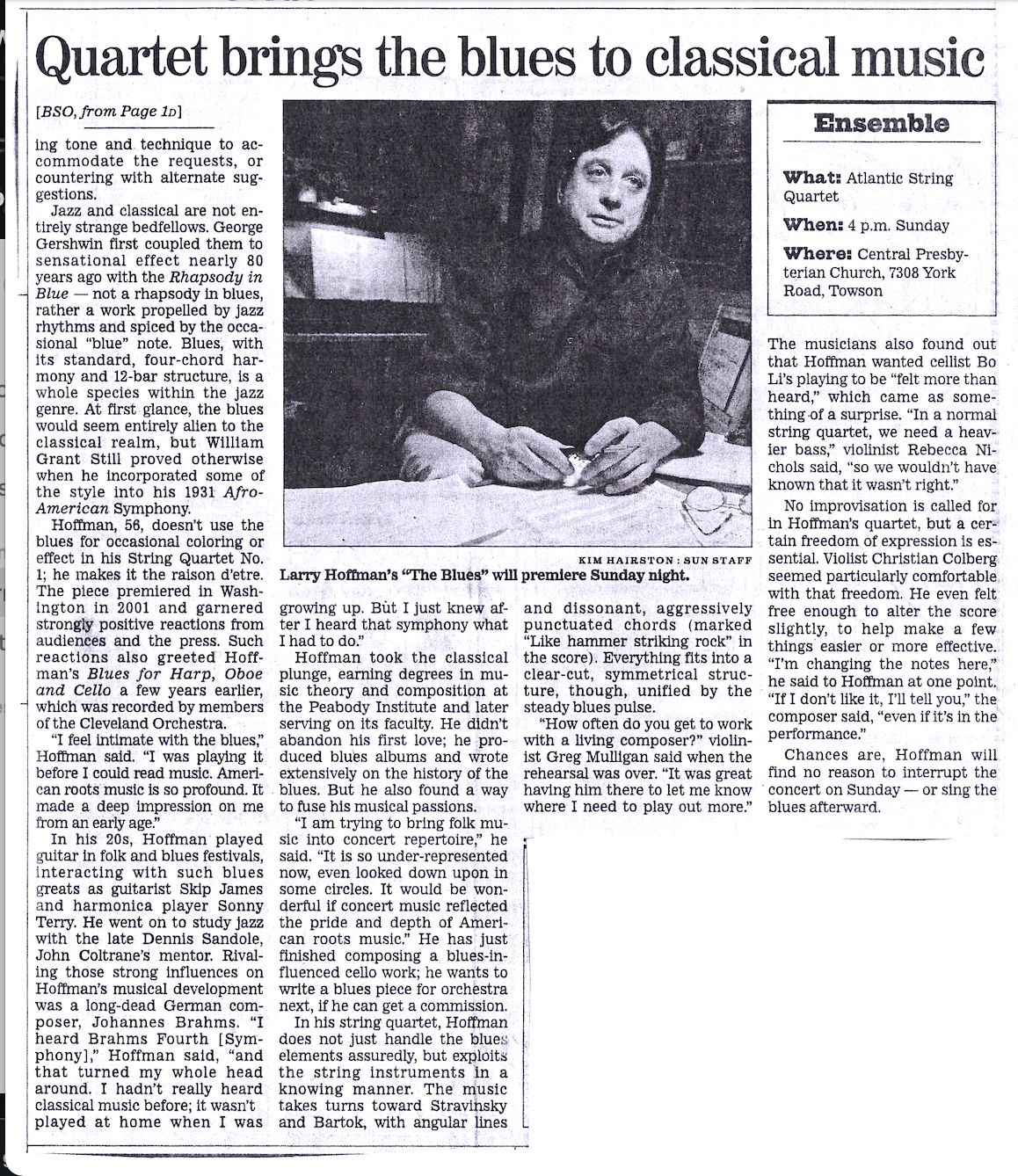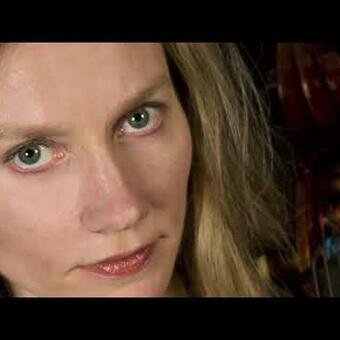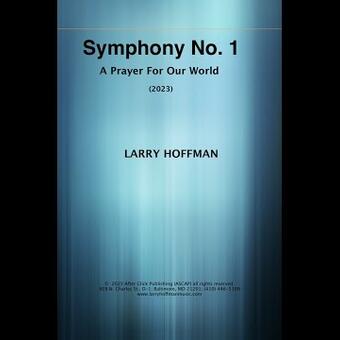About Larry

Grammy-nominee Larry Hoffman is an award-winning composer whose works have been performed throughout the United States and in Europe. While earning his Bachelor’s and Master’s degrees in theory and composition from the Peabody Conservatory, he received grants from the Fromm Music Foundation at Harvard and the American Music Center. Upon graduation, Larry was the recipient of Peabody’s Gustav Klemm Award… more
Blues for Harp, Oboe, and Violoncello
Blues For Harp, Oboe, and Violoncello (1986) was my first effort to create a blues-inspired work that could distill and express blues essence via classical instrumentation and contemporary compositional technique. The mission to put blues on the serious concert music stage was the primary force leading me to composition; I was hoping that this "experiment" would be successful.
The performance presented here (and on my CD) is the result of three extraordinary talents.
Thanks to CRS Records, my piece fell into the accomplished hands of cellist Bryan Dumm, Yolanda Kondonassis, and oboist John Mack. Mr. Dumm is a well-regarded veteran of the acclaimed Cleveland Orchestra. Ms. Kondonassis is a world-renown harpist who made her debut with the New York Philharmonic at age eighteen. She is celebrated as one of the world's premiere and most recorded solo harpists; John Mack was hailed by the New York Times as "the dean of American oboists," regarded as among the top two or three in the world.
“I should have had holes put in my shoes to create a more authentic performance," legendary oboist John Mack quipped to me before the Cleveland premiere.
Needless to say, I was honored to include the artistry of these three stellar musicians on my CD.
I am proud to say that Blues For Harp, Oboe, and Violoncello has proven to be my most- performed piece; one that has gotten the attention of fine musicians from around the USA and Europe. The world premiere was performed by Pittsburgh
Orchestra musicians (who performed the work in PA twice). It was played then in Cleveland, OH ; Washington, D.C.; Stockholm, Sweden; Jackson, MS; and, last I heard, at the Breckenridge Music Festival in Breckenridge, Colorado. I suspect that it was performed in other cities as well -- at least the musicians other cities have acquired score and parts from me with that intention!
-
Blues for Harp, Oboe, and Violoncello (1986)
"Blues for Harp, Oboe, and Violoncello" was my first attempt at infusing a contemporary classical work with blues essence. Putting the blues on the American serious concert music stage was a primary mission that originally drove me to composition. The performers who recorded this work were each stellar and well-known to serious listeners of classical music. Oboist John Mack was dubbed by the New York Times "the dean of American oboists," harpist Yolanda Kondonassis the elegant winner of countless international awards, debuting at age 18 as a soloist with the New York Philharmonic, and cellist Bryan Dumm, a highly respected cellist of the Cleveland Orchestra honored me with both this recording and a special live performance in Cleveland,Ohio. This performance can be found on my CD, "Works of Larry Hoffman / Contemporary American Music.
-
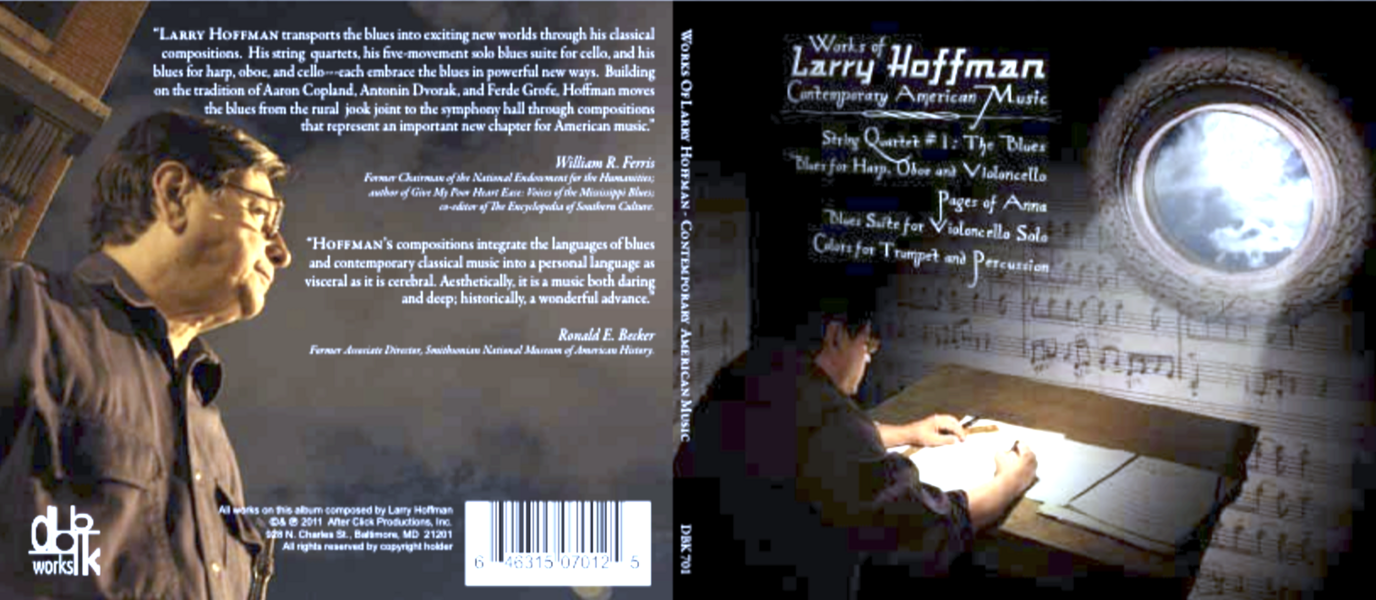 cd cover.png"Blues for Harp, Oboe, and Violoncello" can be found on my CD: "Works of Larry Hoffman: Contemporary American Music" (DBK 701)
cd cover.png"Blues for Harp, Oboe, and Violoncello" can be found on my CD: "Works of Larry Hoffman: Contemporary American Music" (DBK 701) -
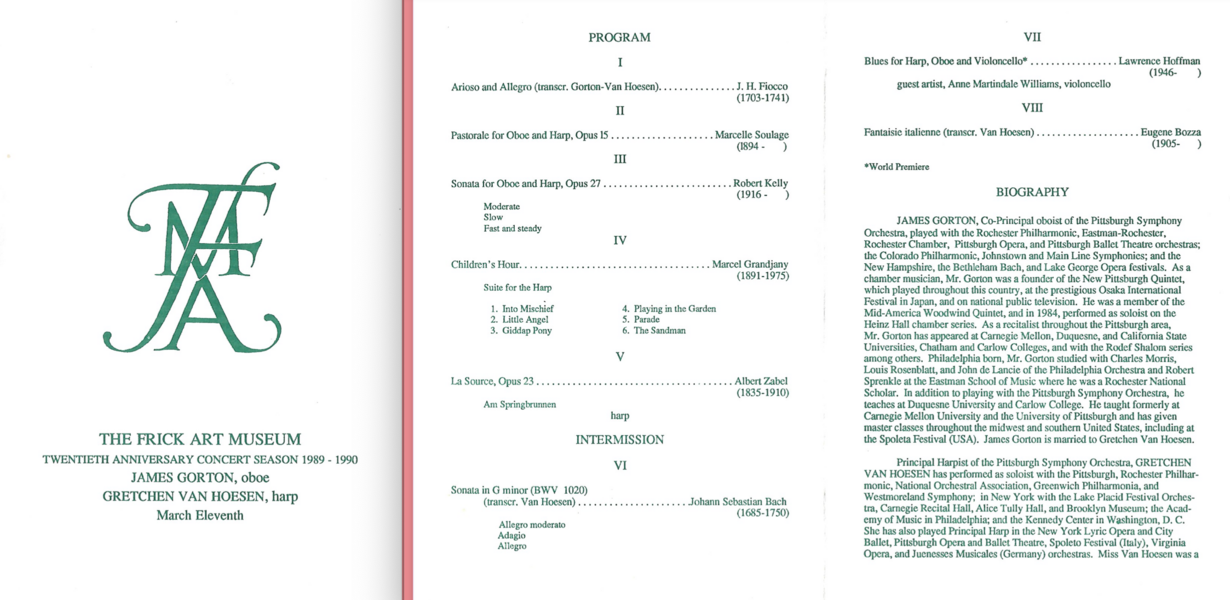 The World Premiere ! Pittsburgh, PA
The World Premiere ! Pittsburgh, PA -
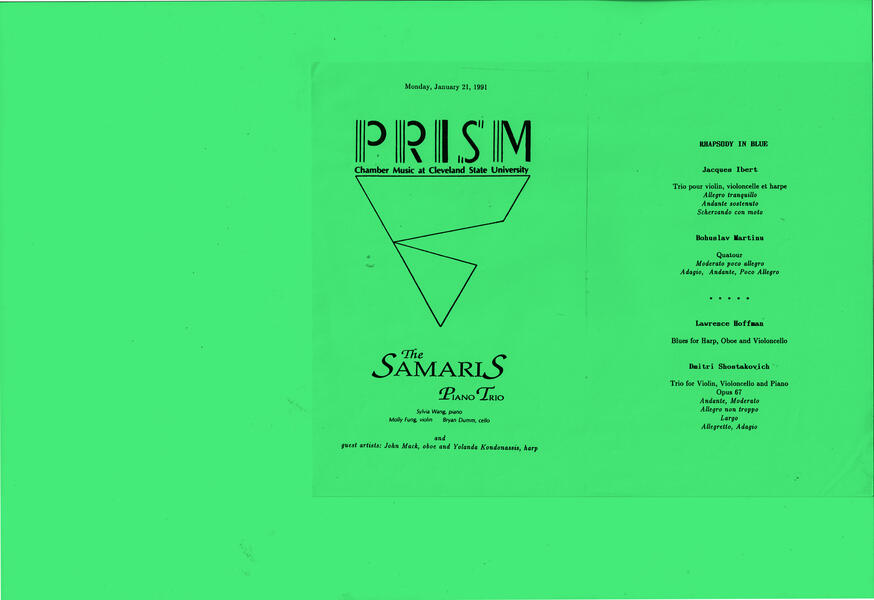 The Cleveland performance.jpgThis is the recording of "Blues For Harp, Oboe, and Violoncello" on "Works of Larry Hoffman: Contemporary American Music,"DBK Records,-- performed by John Mack, Yolanda Kondonassis, and Bryan Dumm
The Cleveland performance.jpgThis is the recording of "Blues For Harp, Oboe, and Violoncello" on "Works of Larry Hoffman: Contemporary American Music,"DBK Records,-- performed by John Mack, Yolanda Kondonassis, and Bryan Dumm -
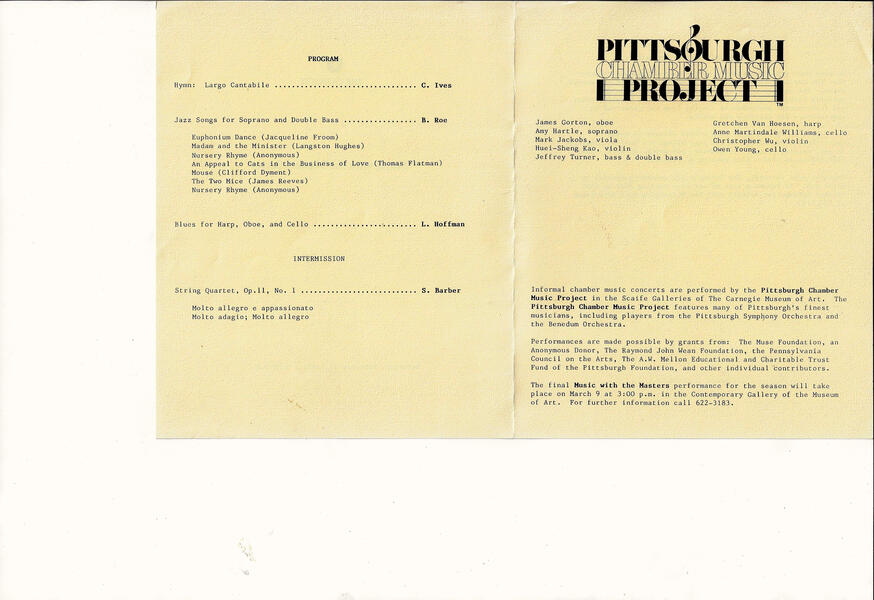 The second Pittsburgh performance
The second Pittsburgh performance -
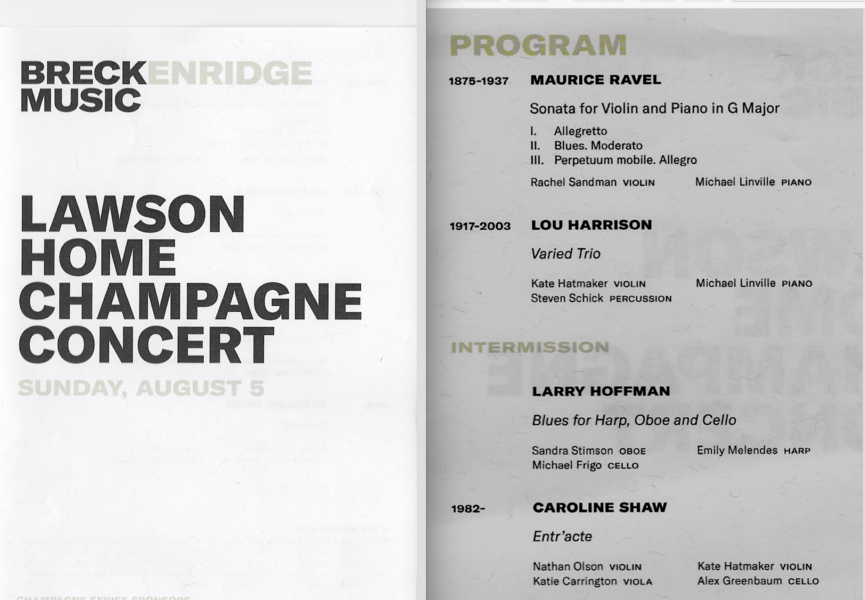 The Breckenridge Music Festival performance
The Breckenridge Music Festival performance
STRING QUARTETS
String quartets are to me the most intimate of ensembles. Homogenous, each instrument speaks exactly the same language, but yet each unique in tone color and range. The possibilities are endless, as evidenced in the great works of Mozart, Haydn, Beethoven, and modern masters such as Bartok and Carter.
"In a letter to the composer Zelter in 1829, Goethe described the string quartet as a conversation between four reasonable, intelligent people, and no one fostered that conversation with as much wit and elegance as Haydn."
-
String Quartet No.10 : Blue Swoon
This is my latest quartet (2023). Although many of my works are blues-oriented, this one was done especially in honor of my very first string quartet, which was one of the very first pieces that affirmed my goals.
This one, however, is my favorite.
-
String Quartet No.9: Quolibet
I came to the creation of this work from my studies of music in the 15th and 16th centuries. Quodlibets were enjoyable works featuring the combination of sometimes disparate elements.
Quodlibet, (Latin: “what you will”) musical composition in which several well-known melodies are combined, either simultaneously or, less frequently, sequentially, for humorous effect. Quodlibet can also refer to an amalgamation of different song texts in a vocal composition.
-
String Quartet No 1. The Blues Larry Hoffman
This is the work that marked my return to composition after a long absence during which I became a blues journalist and record producer. It was a wonderful leap into a music that had meant so much to me earlier in my life and career. I traveled the country, hearing and meeting bluesmen and women, writing about them, and sometimes discovering them, helping them jump-start a career.
Along the way I garnered a Grammy nomination, and awards for producing and writing about the blues internationally.
-
String Quartet No. 2
In my second string quartet I presented the blues in four keys-- first separately, then simultaneously--coming together in a four-voice fugue in which each instrument presented a blues sequence in its own key. It is rigorously controlled, presenting dissonant collisions, each resolving in a unique way. In the center there is a development section that presents some wonderful opportunities.
This recorded performance was executed perfectly and most expressively by the Dover Quartet, early in their career when they were the first resident string quartet at the prestigious Curtis Institute of Music. The extraordinary Dover Quartet has deservedly won the most impressive of awards, and been hailed by perhaps every major publication worldwide.
Dover not only recorded the work but premiered it as well. That afternoon performance remains one of my most touching moments as a composer.
-
String Quartet No 3: Mo' Better Blues
"String Quartet No.3: Mo'Better Blues" opens with a long set of bluesy variations, each unfolding in an improvisatory manner. Towards the center-end there is an atonal episode that is strong and declamatory , lending an air of strength and vigor to the affair. The closing unites both temperments.
My friend, Milena, iconic violist of the Dover Quartet remarked how much she liked the piece.
-
Larry Hoffman : String Quartet No 4 : I. Dance II. Chill III. Get Funky
In my fourth quartet I was interested in creating a string quartet that explored radically different moods. -- more free-form and exuberant than other of my works. The first movement is wild and exuberant - free and confident. The second movement, one of aching and pleading. -- bordering on the melancholy, and perhaps a reconsideration of the abandonment of movement I. In movement III a sweet consensus is reached: get funky and enjoy. And finally, a prayer.
-
String Quartet No. 5 / Through A Glass Darkly
2020 was a very challenging year for most of us. In the midst of the pandemic, the unrest leading to unspeakable violence, economic peril and joblessness, there was also the bright light of hope that showed through the cracks in the darkness. This, my latest work, is the result of that dichotomy.
-
Freight Train Variations : String Quartet No. 6
When I was fifteen, my folk trio had the honor of opening for iconic folksinger/ songwriter/ guitarist Elizabeth Cotten.
I learned to fingerpick on guitar by learning this famous song from her first Lp record. This was one of the first songs I sang and played on the guitar using her famous "Cotten pick" finger technique. As the years went by, and I began composing, I badly wanted to create an homage to her and that famous song that had meant so much to me--- a version that might take its place in the classical repertory. This was the inspiration for this string quartet. I hope that it communicates the beautiful simplicity and universality of the song written by the late Ms. Cotten-- it is without question a true American masterpiece. Currently it is expecting a premiere in Ms. Cotten's home state of North Carolina.
-
String Quartet No. 7 : SIMPLY BLUETIFUL
In this quartet I tried to unite blues ambience with obvious romanticism--a touch akin to a jazz ballad, or a sweeping nocturne. I extended harmonies in a traditional way, but one never found in blues. I particularly like this work in that I linked the ambience that might be found in ''World War II movies" with contemporary blues: at least that was the idea!
-
Chimera Rag / String Quartet No.8
I have always loved ragtime. As a student in the conservatory I was awarded a large version of the Scott Joplin stamp-- an event presided over by the Postmaster General, in celebration of the work I was doing with black music and young black musicians. I know how Mr. Joplin felt when his musical gems were considered merely confections, despite the composer's creation of operas, and his studies at a conservatory. I felt the greatness of those works and of the composer's spirit. I composed this in veneration of Mr. Joplin and his many works.
Ann Charters, celebrated ragtime pianist and ragtime expert-- the wife of icon Sam Charters wrote :
“I especially enjoyed CHIMERA RAG because while it had the charming link in structure to classic ragtime, your melodies & arrangement made it an original work of your own. Don’t stop composing, Larry. You possess a unique talent & your listeners look forward to hearing more!”
MSD Strong /for Orchestra
In remembrance of the horrendous Parkland massacre. A dedication to the survivors' bravery and commitment -- as we remember and mourn the seventeen slain students at Marjory Stoneman Douglas High School, Parkland, Florida; February 14, 2018.
My orchestral tribute to the Parkland Five
This is a programmatic work intended to recreate my musical vision of this event, separated into six brief movements:
I. Prologue and Routine / II. The Classroom / III. Heinous Monster /
IV. Dead Silence / V. Endless Grief / VI. MSD!: March For Our Lives.
What is not heard in this replication is the chant that the orchestra players are to shout in the last movement : “MSD !…. MSD STRONG !, a rallying call of the school’s initials shouted to and from the groups of students who were marching.
I was moved to compose this work as a response to the infinite sadness, empathy, and ANGER that I felt, having the privilege of standing with these proud and brave survivors that day in Washington, DC.. this is how I described it :
"Yesterday, at 8 AM I traveled by train to the “March For Our Lives” rally in Washington, D.C… I went there in support of the amazing young people who, it seems, might be this nation’s only hope to ever reverse the absurd homicidal direction that the lack of reasonable gun laws has allowed. This very intelligent and effective movement is now comprised of young people around the country who have suffered gun violence. It has partnered survivors of the latest horrendous massacre at Parkland, Florida with those of Columbine, Sandy Hook, Newtown, Pulse, Charleston, et al . It has also joined forces with youth groups in Chicago, Los Angeles, and other cities that have long been dealing with gun violence— or the threat of it— every single day.
The speakers ranged in age from eight to nearly 20 years of age-- they were not speaking out of political bent or ego of position; they were angry and showed justification; they were passionate and let their passion erupt; they were politically aware of the difficult political realities that lay ahead, and showed a firm commitment to stay on course. Each had his or her own poetry and was unique.
I am hardly ashamed to say, that tears were in my eyes most of the day… it was deadly serious, endlessly sad, and yet excitingly hopeful.
Scattered, but in force among the crowd, were many students, both current and alumni— from Parkland, Florida’s Marjory Stoneman Douglas High School ( “MSD!!” as they chanted loudly throughout the event..”MSD STRONG!!”). These were the young people who suffered the life-changing trauma and unfathomable grief at losing family and friends to the latest of heinous mass child murder in the United States.
The crowd of 800,000 people, of all ages, ethnicities, and denominations was overwhelming. We were all standing so close to each other that our bodies seemed linked as one, to the cause.
I picked up conversations that led me to believe that some of the survivors were next to, and behind me.
Turning to a girl directly behind me I said, “Were you there that day?” She responded softly, “No, but my friend was,” pointing to a younger girl standing next to her. The second girl looked at me with tears in her eyes, baring a depth of grief I have never before seen in the eyes of anyone. As she looked at me—as if for answers— all I could say was, “I am so sorry that happened to you and your friends.” I heard myself say, ”..it is unspeakable”. A woman who I believe was her mother, and perhaps an affiliate at the school, locked eyes with me, echoing the depth of her daughter’s grief. A young man was to my right, and it occurred to me that he might too be part of the Stoneman group. I asked him if he was at the scene, and he told me that he wasn’t in the same room as the shooter but down the hall or in another building close by… His eyes, too, welled up throughout the day.
I had precious little to offer … besides a continuing commitment to become more involved. More a part of this heroic, historical national movement —however I could—a movement that exposes one of the ugliest, gaping rips in the American texture. I said to an older African American gentleman standing next to me with his family, “Today we are all MSD.”
In remembrance of the horrendous Parkland massacre. A dedication to the survivors' bravery and commitment -- as we remember and mourn the seventeen slain students at Marjory Stoneman Douglas High School, Parkland, Florida; February 14, 2018.
My orchestral tribute to the Parkland Five
This is a programmatic work intended to recreate my musical vision of this event, separated into six brief movements:
I. Prologue and Routine / II. The Classroom / III. Heinous Monster /
IV. Dead Silence / V. Endless Grief / VI. MSD!: March For Our Lives.
What is not heard in this replication is the chant that the orchestra players are to shout in the last movement : “MSD !…. MSD STRONG !, a rallying call of the school’s initials shouted to and from the groups of students who were marching.
I was moved to compose this work as a response to the infinite sadness, empathy, and ANGER that I felt, having the privilege of standing with these proud and brave survivors that day in Washington, DC.. this is how I described it :
"Yesterday, at 8 AM I traveled by train to the “March For Our Lives” rally in Washington, D.C… I went there in support of the amazing young people who, it seems, might be this nation’s only hope to ever reverse the absurd homicidal direction that the lack of reasonable gun laws has allowed. This very intelligent and effective movement is now comprised of young people around the country who have suffered gun violence. It has partnered survivors of the latest horrendous massacre at Parkland, Florida with those of Columbine, Sandy Hook, Newtown, Pulse, Charleston, et al . It has also joined forces with youth groups in Chicago, Los Angeles, and other cities that have long been dealing with gun violence— or the threat of it— every single day.
The speakers ranged in age from eight to nearly 20 years of age-- they were not speaking out of political bent or ego of position; they were angry and showed justification; they were passionate and let their passion erupt; they were politically aware of the difficult political realities that lay ahead, and showed a firm commitment to stay on course. Each had his or her own poetry and was unique.
I am hardly ashamed to say, that tears were in my eyes most of the day… it was deadly serious, endlessly sad, and yet excitingly hopeful.
Scattered, but in force among the crowd, were many students, both current and alumni— from Parkland, Florida’s Marjory Stoneman Douglas High School ( “MSD!!” as they chanted loudly throughout the event..”MSD STRONG!!”). These were the young people who suffered the life-changing trauma and unfathomable grief at losing family and friends to the latest of heinous mass child murder in the United States.
The crowd of 800,000 people, of all ages, ethnicities, and denominations was overwhelming. We were all standing so close to each other that our bodies seemed linked as one, to the cause.
I picked up conversations that led me to believe that some of the survivors were next to, and behind me.
Turning to a girl directly behind me I said, “Were you there that day?” She responded softly, “No, but my friend was,” pointing to a younger girl standing next to her. The second girl looked at me with tears in her eyes, baring a depth of grief I have never before seen in the eyes of anyone. As she looked at me—as if for answers— all I could say was, “I am so sorry that happened to you and your friends.” I heard myself say, ”..it is unspeakable”. A woman who I believe was her mother, and perhaps an affiliate at the school, locked eyes with me, echoing the depth of her daughter’s grief. A young man was to my right, and it occurred to me that he might too be part of the Stoneman group. I asked him if he was at the scene, and he told me that he wasn’t in the same room as the shooter but down the hall or in another building close by… His eyes, too, welled up throughout the day.
I had precious little to offer … besides a continuing commitment to become more involved. More a part of this heroic, historical national movement —however I could—a movement that exposes one of the ugliest, gaping rips in the American texture. I said to an older African American gentleman standing next to me with his family, “Today we are all MSD.”
-
MSD STRONG: IN MEMORY OF SEVENTEEN SLAINThis is a work I created to commemorate the senseless slaying of seventeen students at Marjory Stoneman Douglas High School (MSD) in Parkland, Florida on February 14, 2018. It is dedicated to the fallen students, and to "The Parkland Five," who courageously stood their ground in the days and weeks that followed, and who still fight for what is right. In remembrance of the horrendous Parkland massacre. A dedication to the survivors' bravery and commitment -- as we remember and mourn the seventeen slain students at Marjory Stoneman Douglas High School, Parkland, Florida; February 14, 2018. My orchestral tribute to the Parkland Five This is a programmatic work intended to recreate my musical vision of this event, separated into six brief movements: I. Prologue and Routine / II. The Classroom / III. Heinous Monster / IV. Dead Silence / V. Endless Grief / VI. MSD!: March For Our Lives.
Antics for Oboe and Clarinet
Casual voices diving and twisting, meeting harmoniously then darting quickly away-- each to its highest heights and deepest lows.... sweeping....
This went on in my mind's ear all weekend-- on airplanes, in hotels, coffee shops, and airports... until I was entirely intrigued.
When I arrived back home, I had a new piece!
-
Antics for Oboe and ClarinetThis piece came as a complete surprise while I was traveling to and from a music event in Austin, Texas. On airplanes, motels, coffee houses,,,,,,the prospect of counterpoint between these two related but entirely different instruments intrigued me. It was a long discussion :)
-
Pages of AnnaThis work was featured on my CD "Works of Larry Hoffman: Contemporary American Music." It is scored for Flute, Oboe, Clarinet, and Harp. It is a computer realization sequenced and mixed by award-winning composer Geoff Knorr. This music was engendered by my wrangle with budding love gone awry. Some people singled out this work as their favorite on the program.
-
Pages of Anna: score.JPGHere is a look at some pages of "Pages of Anna" :)
-
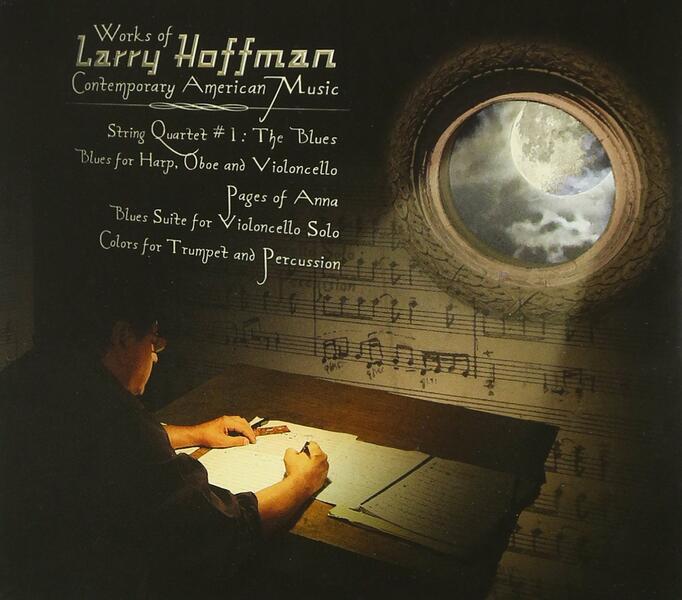 Works of Larry Hoffman .jpgPages of Anna is featured on my CD: "Works of Larry Hoffman"
Works of Larry Hoffman .jpgPages of Anna is featured on my CD: "Works of Larry Hoffman"
String Quartet No.5 Through a Glass Darkly
-
String Quartet No. 5 / Through A Glass Darkly2020 was a very challenging year for most of us. In the midst of the pandemic, the unrest leading to unspeakable violence, economic peril and joblessness, there was also the bright light of hope that showed through the cracks in the darkness. This, my latest work, is the result of that dichotomy.
Blue Mirror for Solo Guitar (2016)
The nuances of the blues are incredibly and wonderfuly complex and expressive, both from a rhythmic as well as a melodic aspect. Microtones of all stripes abound, shaded by glissandi both subtle and gross, while the rhythms -- sometimes erratic-- chug on. The harmonic patterns, usually stretching no further than the tonic-subdominant-dominant orbit, are somehow made fresh, as are the blues scales (primarily pentatonic) by their bent and shaken and sliding notes. Much of this is due to the highly personalized languages of the blues, remade anew by each of the authentic, creative artists who shaped and reshaped this great music over the decades.
The blues sections of this work are drawn from my original blues music, laced with -- and sometimes based on-- the authentic underpinnings of the traditional music.
There is no improvisation whatever! Each nuance is carefully notated. I had to invent certain techniques to bring about the "non-western" elements. But if followed carefully, the score will produce the authentic sound that is present in this performance.
-
Blue Mirror / for Solo GuitarThis is my first work for guitar. It is another synthesis of my atonal voice, and original blues. It is ironic perhaps that I have been playing guitar for over fifty years and—besides some early blues instrumentals written and notated clumsily before I could read music, and some songs for which the guitar was mostly accompaniment -- I never really composed for the guitar. I am beginning to come to terms with my instrument in an entirely new way. I feel like I am finally beginning to listen to my guitar of fifty years, understanding how she thinks, and discovering her in entirely new ways— exciting. After playing clubs for nearly ten years, I remained an inveterate improvisor and composer... my ideas came by ear and by mystery ... And so, when it finally came down to notating the personal blues style that I had cultivated for guitar over many years, I was at a loss. My earliest attempt at a score was more a cry for help!
-
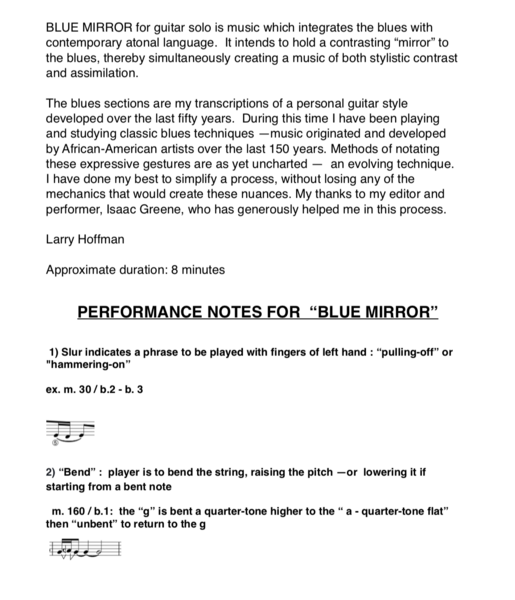 "Blue Mirror" performance notes p.1This is page one of the detailed performance notes
"Blue Mirror" performance notes p.1This is page one of the detailed performance notes -
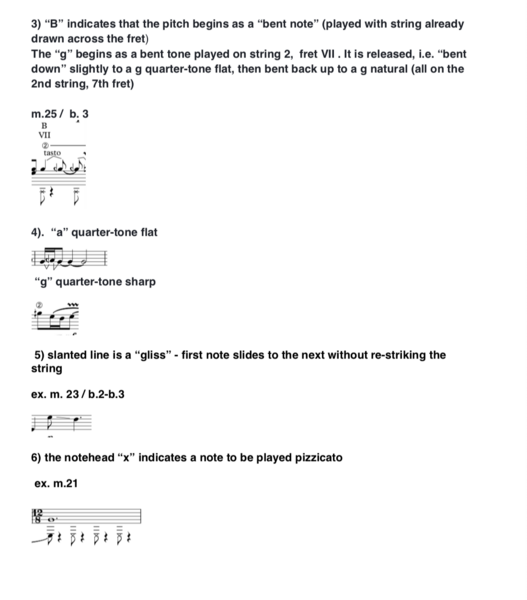 "Blue Mirror" performance notes, page 2performance notes page 2
"Blue Mirror" performance notes, page 2performance notes page 2 -
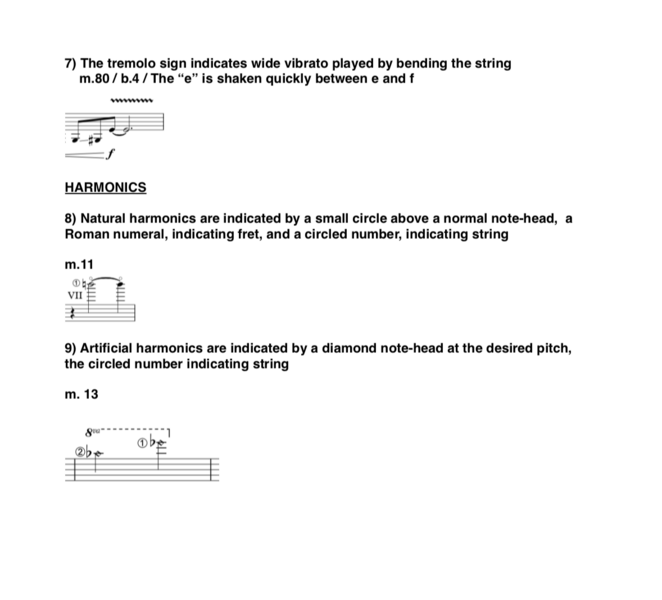 "Blue Mirror" performance notes , p.3performance notes / page 3
"Blue Mirror" performance notes , p.3performance notes / page 3 -
Blues Suite for Violoncello Solo / Kristin OstlingConceived in five movements, this blues-inspired piece is a homage to J.S.Bach and his immortal cello suites -- ever an inspiration.
String Quartet No.2
In String Quartet No. 2 I extended my concept, employing four different keys -- sequentially -- each joined to the other in turn, until all were spun together as a fugue standing as the work's climax. The Dover Quartet, who recorded this work as The Old City Quartet, also premiered this piece in concert. The Dover ensemble is simply wonderful; and, at the time of the recording, was the finest string quartet at the renowned Curtis Institute of Music -- and the first string quartet in residence there.
Among their many prizes and awards are as follows: three Special Prizes at the 2013 Banff International String Quartet Competition, the highly prestigious Cleveland Quartet Award, Lincoln Center's Hunt Family Award, the grand prize at the Fischoff Competition, and special prizes at the Wigmore Hall International String Quartet Competition. Their recording of this work can be found on the recorded compilation: "Mozart & The Contemporaries ," 2011 (CRS CD1191) ©2011 CRS Artists
https://www.discogs.com/The-Old-City-String-Quartet-John-Russo-Mozart-The-Contemporary/release/8666307
-
String Quartet #2 Dover Quartet
-
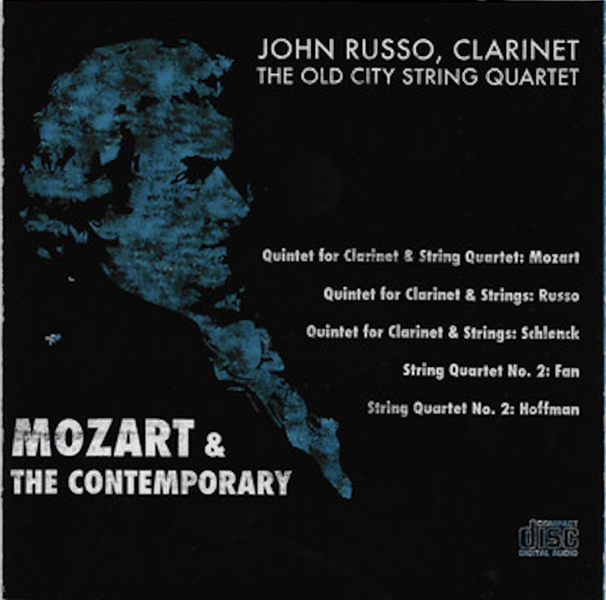 "String Quartet No.2" by the Dover Quartet can be found on "Mozart & The Contemorary" CRS Records
"String Quartet No.2" by the Dover Quartet can be found on "Mozart & The Contemorary" CRS Records -
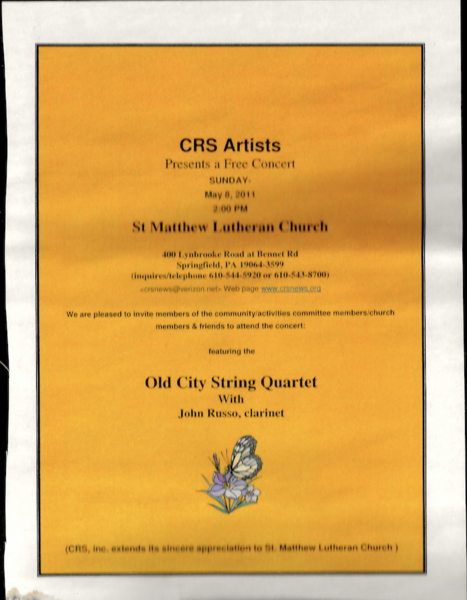 Dover Quartet Premiere of "String Quartet No.2"I had not yet heard of this quartet (then famous at their Philadelphia alma mater, the Curtis Institute of Music), but I was glad to hear that clarinetist John Russo, CEO of CRS Records, had engaged an excellent quartet to record my piece. They were then known as "The Old City Quartet." We had a few telephone conversations regarding the piece; and, when I said,"You know the work is polyphonic, written in four keys!" My friend Milena, the mega-talented violist of the ensemble, responded: "We knew that!" And at that point I realized I was on board with some very special musicians. I regret to this day that I did not make the trip to Philadelphia to rehearse and work with them on the piece. It was on a teaching day; and I never miss them. My presence could not have improved their performance, however. They were amazing, and it is a day I will never forget. A small crowd huddled in a church outside of Philadelphia on that Sunday afternoon, anticipating the live program of a soon-to-be-released CD. The quartet was slightly late, and Milena called me to say they were on the way. When they arrived I showed them in, and offered them a room where they could relax after the drive, tune, and warm up. Hurrying with me into the hall, Milena said, "That's okay, we're good." And they immediately, soundlessly, took the stage, unpacked their instruments, and proceeded to flawlessly perform two premieres of contemporary works and Mozart's clarinet quintet, featuring the aforementioned John Russo at the helm -- without a break! The group's consummate attention to detail; their innate talent and ensemble rapport stunned me.. for lack of a better word. All the hard work over months bringing the work to life, all the countless hours were now repaid in full; and I will always be grateful for their work and that day!
Dover Quartet Premiere of "String Quartet No.2"I had not yet heard of this quartet (then famous at their Philadelphia alma mater, the Curtis Institute of Music), but I was glad to hear that clarinetist John Russo, CEO of CRS Records, had engaged an excellent quartet to record my piece. They were then known as "The Old City Quartet." We had a few telephone conversations regarding the piece; and, when I said,"You know the work is polyphonic, written in four keys!" My friend Milena, the mega-talented violist of the ensemble, responded: "We knew that!" And at that point I realized I was on board with some very special musicians. I regret to this day that I did not make the trip to Philadelphia to rehearse and work with them on the piece. It was on a teaching day; and I never miss them. My presence could not have improved their performance, however. They were amazing, and it is a day I will never forget. A small crowd huddled in a church outside of Philadelphia on that Sunday afternoon, anticipating the live program of a soon-to-be-released CD. The quartet was slightly late, and Milena called me to say they were on the way. When they arrived I showed them in, and offered them a room where they could relax after the drive, tune, and warm up. Hurrying with me into the hall, Milena said, "That's okay, we're good." And they immediately, soundlessly, took the stage, unpacked their instruments, and proceeded to flawlessly perform two premieres of contemporary works and Mozart's clarinet quintet, featuring the aforementioned John Russo at the helm -- without a break! The group's consummate attention to detail; their innate talent and ensemble rapport stunned me.. for lack of a better word. All the hard work over months bringing the work to life, all the countless hours were now repaid in full; and I will always be grateful for their work and that day! -
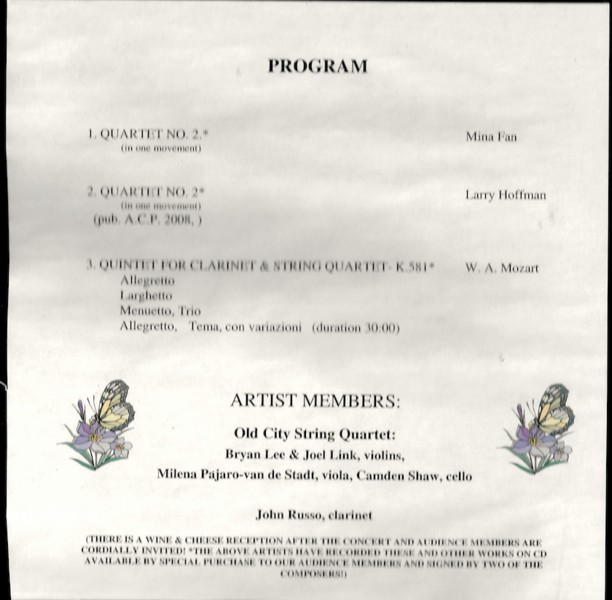 Program: premiere of String Quartet No.2 / Dover Quartet
Program: premiere of String Quartet No.2 / Dover Quartet -
String Quartet No. 7 : SIMPLY BLUETIFULIn this quartet I tried to unite a blues ambience with an obvious romantic touch, one akin to a jazz ballad, or a sweeping nocturne. I extended harmonies in a traditional way, but one never found in blues.
String Quartet #1: The Blues ; lecture/ performance
This is my most-performed work. At least five string quartets have performed it both here in the USA and abroad. It had its premiere as part of the Smithsonian Institution Chamber Music Series, the fine Axelrod String Quartet receiving standing ovations at the conclusion of both performances that weekend. It has been peformed in Sweden multiple times, and featured on local television in Baltimore. The present performance was part of a program held at Harold Washington Library in Chicago during the same weekend that my "Three Songs for Bluesman and Orchestra" -- a work commissioned by the Chicago Sinfonietta--was premiered at Dominican College and repeated the next evening at Symphony Center, home of the Chicago Symphony.
"Speaking of The Blues," a program held at Chicago's Harold Washington Library on May 9, 2008, featured composer Larry Hoffman and his work, "String Quartet #1: The Blues," as performed by the New Millennium Orchestra String Quartet : Elizabeth Choi, first violin; Blagomira Lipari, second violin; Dominic Johnson (leader), viola; and Eric Schaeffer, violoncello.
I was interviewed by--and discussed various aspects of the blues with host Barry Dolins, series founder, blues aficionado, and Chicago's Deputy Director at the Mayor's Office Of Special Events.
This video is presented courtesy of the Music Division of the Chicago Public Library: Christopher Popa, Executive Producer of video; and Director, Music Information Center, Chicago Public Library.
Digital / audio transfer by Ed Tetreault, manager of The Peabody Conservatory Department of Recording Arts & Sciences.
Music Division Of The Chicago Public Library
Composer / Speaker: Larry Hoffman
Host / Speaker: Barry Dolins
Musicians: New Millennium Orchestra String Quartet
Violin I: Elizabeth Choi
Violin 2: Blagomira Lipari
Viola (leader): Dominic Johnson
Violoncello: Eric Schaeffer
Music Information Director: Christopher Popa
Digital Transfer: Ed Tetreault
Eighteen Hammers by Johhny Lee Moore ©Atlantic/Rhino runs over beginning credits.
-
String Quartet No 1. The Blues Larry HoffmanThis is the work that marked my return to composition after a long absence during which I became a blues journalist and record producer. It was a wonderful leap into a music that had meant so much to me earlier in my life. I traveled the country, hearing and meeting bluesmen and women, writing about them, and sometimes discovering them, helping them jump-start a career. Along the way I garnered a Grammy nomination, and awards for producing and writing about the blues internationally. I was talked back into composing by three very close friends who reminded me of what they felt was my "greater purpose." It hit a nerve, and after a while I decided to write a string quartet, which I always felt to be a badge of authenticity for a real composer. My deal with myself was : if it failed, I would continue on my blues path. If it succeeded I would trudge on, trying to create blues -inspired works that would bring a new dimension and respect to that wonderful music.
-
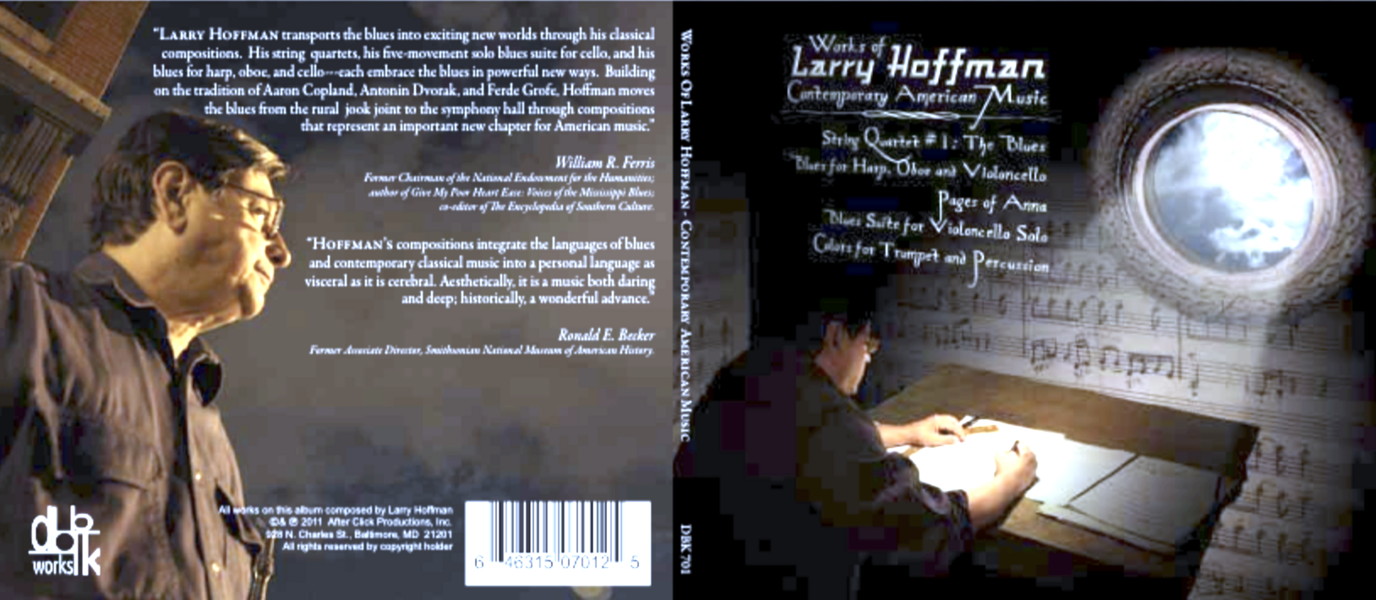 Works of Larry HoffmanString Quartet No.1 can also be heard on my CD "Works of Larry Hoffman" as performed by the fine Atlantic String Quartet (of the Baltimore Symphony Orchestra). They have performed the work often, and do a fine job on this recording. In fact, this ensemble was the very first to have played this work!
Works of Larry HoffmanString Quartet No.1 can also be heard on my CD "Works of Larry Hoffman" as performed by the fine Atlantic String Quartet (of the Baltimore Symphony Orchestra). They have performed the work often, and do a fine job on this recording. In fact, this ensemble was the very first to have played this work! -
 String Quartet No.1 World Premiere .jpgMy first string quartet was premiered by the Axelrod Quartet as part of the Smithsonian Chamber Music Series. It received a standing ovation both nights! What a treat... Thank you, Axelrod Quartet!
String Quartet No.1 World Premiere .jpgMy first string quartet was premiered by the Axelrod Quartet as part of the Smithsonian Chamber Music Series. It received a standing ovation both nights! What a treat... Thank you, Axelrod Quartet! -
 Weber Quartet Stockholm, Sweden.pngThe Weber String Quartet heard about the piece and performed it in Stockholm a number of times.
Weber Quartet Stockholm, Sweden.pngThe Weber String Quartet heard about the piece and performed it in Stockholm a number of times. -
 String Quartet No.1: CHICAGO.pngString Quartet No. 1 was performed as part of Chicago's "Classical Monday" series. The group was put together by violist Dominic Johnson, and included Jeff Yang, violin1; Matt Albert, violin 2; and Nicholas Photinos, cello. Thanks to Matt and Nicholas of "Eighth Blackbird".
String Quartet No.1: CHICAGO.pngString Quartet No. 1 was performed as part of Chicago's "Classical Monday" series. The group was put together by violist Dominic Johnson, and included Jeff Yang, violin1; Matt Albert, violin 2; and Nicholas Photinos, cello. Thanks to Matt and Nicholas of "Eighth Blackbird". -
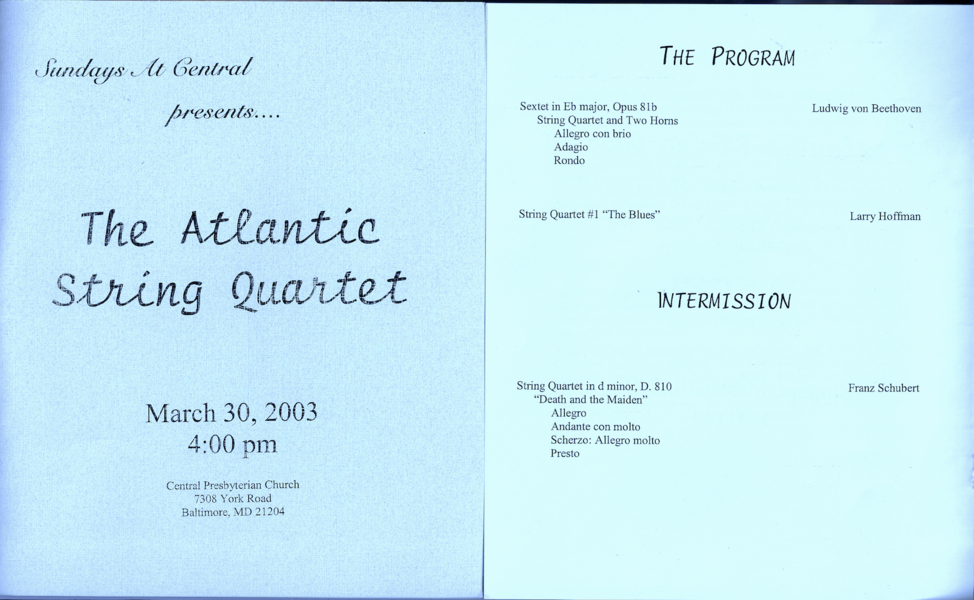 String Quartet No. 1 : The Atlantic String Quartet.pngThis was the Baltimore premiere of "String Quartet No.1: The Blues" featuring the Atlantic String Quartet, made up of artists from the Baltimore Symphony. It got some press in the Baltimore Sun, and there was sure to be a crowd as it is my hometown, and I had been teaching and playing there for years, so I kind of expected it. I will never forget this day. It was the last day of March, and it snowed like crazy! A wild snowstorm and the hall was packed! This is the quartet who recorded the piece on my CD.
String Quartet No. 1 : The Atlantic String Quartet.pngThis was the Baltimore premiere of "String Quartet No.1: The Blues" featuring the Atlantic String Quartet, made up of artists from the Baltimore Symphony. It got some press in the Baltimore Sun, and there was sure to be a crowd as it is my hometown, and I had been teaching and playing there for years, so I kind of expected it. I will never forget this day. It was the last day of March, and it snowed like crazy! A wild snowstorm and the hall was packed! This is the quartet who recorded the piece on my CD. -
String Quartet #1: The Blues / Atlantic String QuartetThe Baltimore premiere of String Quartet No.1: The Blues was performed by the Atlantic String Quartet. It is this performance that is found on my CD "Works of Larry Hoffman: Contemporary American Music."
-
 STRING QUARTET NO 1 Sun.pngThe Baltimore Sun covered the Baltimore premiere of my "String Quartet No.1"
STRING QUARTET NO 1 Sun.pngThe Baltimore Sun covered the Baltimore premiere of my "String Quartet No.1"
Of Seabirds, Palms, and Waves
That is the source of this piece.
The work morphs over and over again from a musical stillness to a fantasia / development, exploiting elements of contrapuntal, timbral, and rhythmic design-- each relating and returning to the original "painting," as in a rondo.
At the musical core of the piece is what I discovered, watching closely the rhythmic motion of the birds, as they moved in an unbroken and continuous pattern. The movements were rhythmically uniformed --although they varied in tempo. This pattern became increasingly more complex as the number of birds increased, and the tempi disparity became more and more pronounced.
Their movements, however, broke into two clear patterns:
1) groups of six steps followed by
2) a smaller number of groups of four steps---always returning to the initial group of six.
Each group was punctuated by an accent on the next-to-last beat. The pattern became This was astonishingly regular -- no variance. The routine created a predictable, rhythmic pattern that I used as a base -- one that interacted contrapuntally with musical representations of the unpredictable parade of "musical winds and oncoming tide," as well as with the random calls of the various birds in flight. Indeed, this was music that needed to be notated and remembered.
-
Of Seabirds, Palms, and WavesOn a trip to an island off of Texas, I spent some time at an isolated beach on a cloudy day. The birds, waves, and palms created a counterpoint that I could not resist. I had to try and capture it in a piece. It is rather long, because the wonderful effect did not come over me until I became part of the wonderful synergy. The birds were walking in two different patterns .. 6/4 and 5/4 -- always with the accent on the next to last beat. This overlapping rhythmic counterpoint between the multiple number of birds was fascinating in and of itself; mixed with the varied sounds of the waves, it was spellbinding. I sent a youtube to the chamber of commerce, and received a wonderful reply.
-
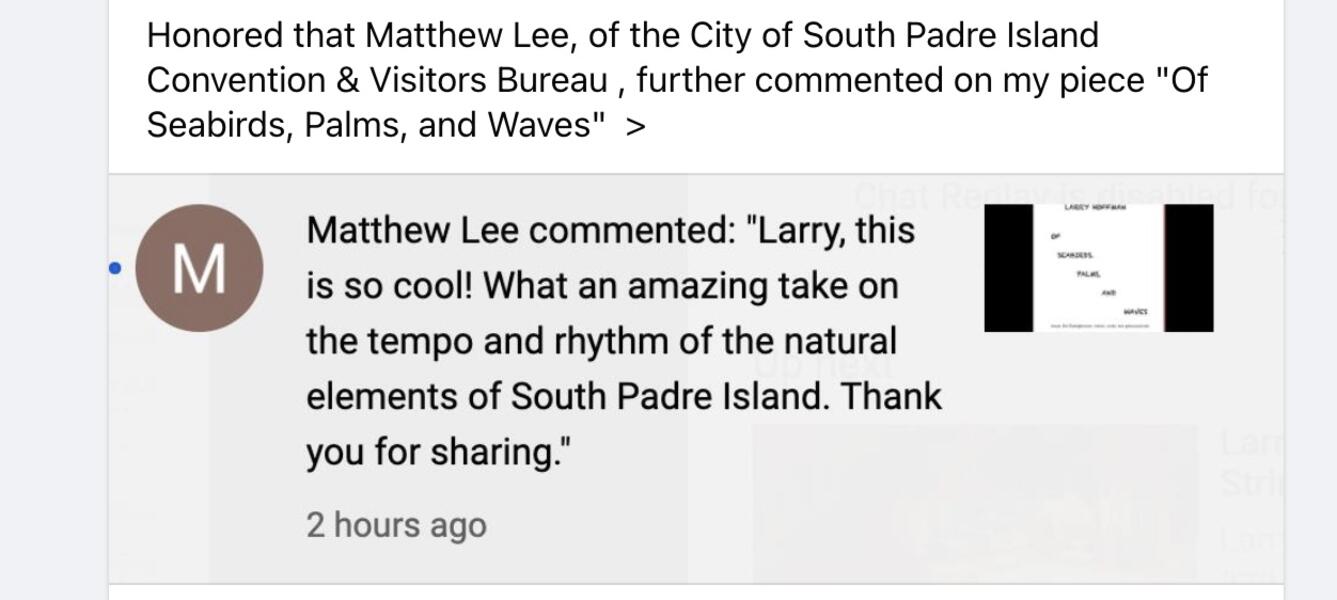 The island of South Padre.jpgI was pleased and honored that the Convention and Visitors Bureau of South Padre Island responded to my work.
The island of South Padre.jpgI was pleased and honored that the Convention and Visitors Bureau of South Padre Island responded to my work. -
 Island response.pngI was happy to read the response of South Padre Island. They experience what I do!
Island response.pngI was happy to read the response of South Padre Island. They experience what I do! -
Colors for Trumpet and PercussionThis work was commissioned by Baltimore Symphony artists Andrew Balio, principal trumpet, and David DePeters, percussionist. They premiered this piece at the Maryland Institute College of Art in Baltimore,Maryland.
-
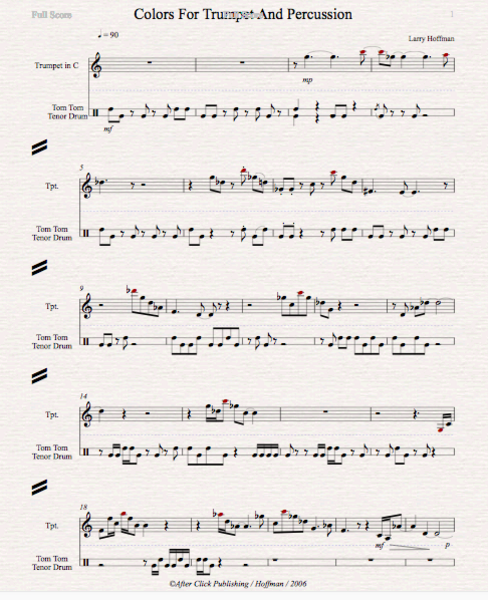 colors page 1.png"Colors" score: Page 1
colors page 1.png"Colors" score: Page 1 -
 COLORS.jpg"Colors" was commissioned by Andrew Balio and David DePeters, highly accomplished professional musicians in the Baltimore, MD area. It was a challenge to find a good balance between the trumpet and a selection of "the right" percussion instruments, but eventually it felt very comfortable, and I was happy with the result. I was honored to get the commission. What made it easy was the confidence I had in the advanced skills of these two instrumentalists.
COLORS.jpg"Colors" was commissioned by Andrew Balio and David DePeters, highly accomplished professional musicians in the Baltimore, MD area. It was a challenge to find a good balance between the trumpet and a selection of "the right" percussion instruments, but eventually it felt very comfortable, and I was happy with the result. I was honored to get the commission. What made it easy was the confidence I had in the advanced skills of these two instrumentalists.
Old Time Music : Woodwind Quintet No.3
This is my homage to "Old Time Music," or "Old -Timey Music" -- the genre of country music that pre-dated and informed bluegrass. "Old time music" is an American folk music that developed in concert with various folk dances, and is said to be the oldest form of North American traditional music other than that of the indigenous Native Americans. To quote Wikipedia, " the roots of old-time music are in the traditional musics of the British Isles (primarily Great Britain and Ireland)-- and Europe. African influences are notably found in instruments such as the banjo."
As a teenager I sought out and learned tunes from recordings of this music, played and sung by revivalist groups like The New Lost City Ramblers. I traced the origin of the songs to the older 78 recordings originally released in the twenties and thirties by great and colorfully-titled groups like "Gid Tanner and the Skillet Lickers."
I sang and played a lot of these tunes on guitar, banjo, and autoharp -- instruments that I taught myself to play. Harmonizing with my friends as we sat around our living rooms, or by the stream across from my parents' house, was a wonderful part of my musical teenage years.
Many years later, I wanted to give this music presence in a "classical format," using traditional compositional techniques to expand on themes, lend different colors, and create contrapuntal webbing and harmonic variance to expand on this wonderful traditional language-- all the while striving to keep close to its roots.
-
Woodwind Quintet #3: Old - Time MusicThis is my homage to Old-Time or Old-Timey music, the genre of country music that preceded and informed bluegrass. It had its day in the 1920s and 30's and is said to be the oldest form of indigenous American folk music, with the exception of Native American music. I spent many hours as a teenager playing this music with friends--and believe it should be represented in the repertoire of American serious concert music. Both movements reflect the American folk dances that evolved simultaneously with this genre of music.
-
Larry Hoffman : String Quartet No 4 : I. Dance II. Chill III. Get FunkyI enjoy composing single-movement works, as they give me more room to develop ideas. The four-movent scheme is prevalent in the classic symphonies and string quartets ( I. Sonata -Allegro / II. Song form /III. Sherzo / IV. Rondo, Sonata-Allegro -or related) , but I am not sure that this convention is in any way mandatory in the twenty-first century :) In this case, I did want to try selecting and identifying specific moods with the three movements.














